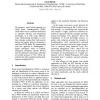ACL
2003
15 years 1 months ago
2003
In this paper, we proposed a new supervised word sense disambiguation (WSD) method based on a pairwise alignment technique, which is used generally to measure a similarity between...
119
Voted
ICAI
2004
15 years 1 months ago
2004
This paper presents a new method for Word Sense Disambiguation based on the WordNet Domains lexical resource [4]. The underlaying working hypothesis is tha...
112
Voted
ACL
2003
15 years 1 months ago
2003
A central problem of word sense disambiguation (WSD) is the lack of manually sense-tagged data required for supervised learning. In this paper, we evaluate an approach to automati...
132
Voted
EMNLP
2006
15 years 1 months ago
2006
Word clustering is important for automatic thesaurus construction, text classification, and word sense disambiguation. Recently, several studies have reported using the web as a c...
70
Voted
EACL
2006
ACL Anthology
15 years 1 months ago
2006
ACL Anthology
The degree of dominance of a sense of a word is the proportion of occurrences of that sense in text. We propose four new methods to accurately determine word sense dominance using...
79
Voted
EACL
2006
ACL Anthology
15 years 1 months ago
2006
ACL Anthology
In this paper a novel solution to automatic and unsupervised word sense induction (WSI) is introduced. It represents an instantiation of the `one sense per collocation' obser...
EMNLP
2004
15 years 1 months ago
2004
This paper explores the large-scale acquisition of sense-tagged examples for Word Sense Disambiguation (WSD). We have applied the "WordNet monosemous relatives" method t...
77
Voted
ACL
2006
15 years 1 months ago
2006
Subjectivity and meaning are both important properties of language. This paper explores their interaction, and brings empirical evidence in support of the hypotheses that (1) subj...
101
click to vote
ACL
2006
15 years 1 months ago
2006
We present a novel hybrid approach for Word Sense Disambiguation (WSD) which makes use of a relational formalism to represent instances and background knowledge. It is built using...
ACL
2006
15 years 1 months ago
2006
This paper presents a new approach based on Equivalent Pseudowords (EPs) to tackle Word Sense Disambiguation (WSD) in Chinese language. EPs are particular artificial ambiguous wor...




